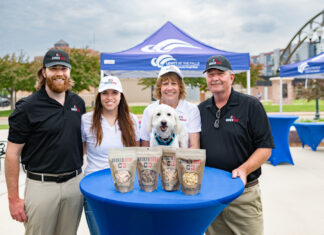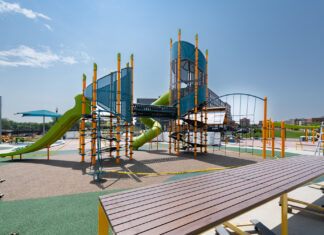One of the truest and most effective forms of parental espionage is having lunch with your child at their school cafeteria. Upon dining with them, you get a very clear view of their school self by noting the following behaviors: What do they eat? How much do they eat? Do they have good manners? Do they clean up after themselves? And, most importantly, with whom do they eat and how do they treat their fellow cafeteria diners? In my short-term career as a school age mom, I have found the answers to all these questions each time I have lunch with my daughter to be incredibly insightful into the budding character of my child.
But my visits to her cafeteria are not always rooted in reconnaissance reasons and tactics. On the contrary, my two-year-old son begs me on the daily to see his sister during the day. Perhaps my glowing presence is not entertainment enough for him? So, more often than not, I will happily oblige and off we go for a cafeteria lunch date.
A few weeks back, I was at the cafeteria and while my children played and stole food from each other, my eyes and ears began taking in all the beautiful chaos that is a school cafeteria. The deafening sound of chatty, hungry children, the clanking sounds of eating utensils on plastic food trays, the palpable high-energy of antsy young children; all making for a nostalgic hum of childhood.
From across the room, I saw one little girl accidently spill the remaining contents of her tray on the floor as she attempted to clean off her tray in the trash. I watched as a number of children nearby stopped their cafeteria happenings to stare at the accident. Meanwhile, two other children behind her immediately set their trays down and began helping the deer-in-the-headlight girl who spilled. After it was all cleaned up and the initial shock of the “embarrassing” spill had worn off, I watched with a smile as the young girl ran off to recess.
Another lunch date on another day I met my sister-in-law at the cafeteria to surprise my daughter with a visit from her aunt and cousins. As we were leaving, we began the herculean task of getting three little ones out of the building and into our cars. Just as we were walking out, my then two-year-old niece did not want to leave the cocoon of fun that is elementary school and sat down in front of the entrance doors and began a soft cry. As my sister-in-law walked over to get her, a group of children walked by and one of the girls stepped out of line to try and help my young niece. I could tell that the young girl was so torn; follow the rules and stay in line on the way to lunch or stay and help the sad sight of a sorrowful two-year-old on the ground? As she knelt down to help my niece, she saw my sister-in-law coming and smiled and continued on her way to lunch.
 Both of these cafeteria scenarios really struck me. The scenarios may seem silly and inconsequential, but in these small acts, I noticed something about those children:
Both of these cafeteria scenarios really struck me. The scenarios may seem silly and inconsequential, but in these small acts, I noticed something about those children:
They stepped out of their own world, and they showed up for someone else.
How do I raise children like that? Children who show up for other people who then become adults who consistently show up for people? Who step out of their world to help? In their generation of “selfies” and “my stories” and incessant personal branding, how do we teach compassion, empathy, and an others-focused perspective?
At some time or another we have been or will be the girl who spilled her entire tray in front of everyone at the cafeteria. Or maybe we will be my precious niece silently sobbing before the world because of some pain or sorrow that was inflicted upon us. Regardless, we all have a time of need … wouldn’t we want someone to show up for us?
I have been both the girl with the tray and my niece many times over in my life. Six years ago, I was riding in a hospital elevator when my prematurely born daughter was in the hospital. I was only 28, a first-time mom, and scared to death of what the future held for my two-pound daughter fighting for her life in an incubator. I had tears in my eyes in the elevator as another mom boarded. She looked at me and said, “Can I hug you? I get it, my son has been here for five months.” We embraced in the elevator and I never saw her again. I was a stranger to her. But, in that moment she showed up. The next day, I got a phone call saying one of my friends was flying in from California to be with me and meet my daughter in the hospital. She didn’t have to spend the money and step out of her world and show up. But, she did. In fact, many people showed up at the hospital for us during that time, and it was them that helped us stay strong for our daughter. Their showing up allowed us to show up, too.
It’s a cycle, empathy and compassion. Once it is given, it’s given again, and again and again. But, it works the other way, too. Once we find an excuse not to give it, it gets easier to withhold over time. It starts to make sense to blame the girl with the tray or the child on the ground crying. We blame the parents. We blame the child’s past. We blame the parent’s past. Instead of just showing up for people, we come up with reasons to vacate and isolate. I know it to be true, because I know I’ve done it.
As a deeply flawed human myself, I don’t know how to 100 percent ensure my children will be the type of people who show up. But, I know it doesn’t hurt to practice. My son has been practicing with our giant dog by showing him kindness and not hitting him with a golf club. It’s a start, right? With my daughter, my husband and I have just encouraged her (and largely ourselves) to look around the “cafeterias” in life. Notice the people showing up for other people and then go off and be one, too.
Follow Tracy on her blog, littleparentontheprairie.com.

















